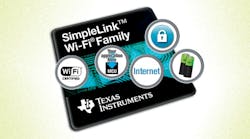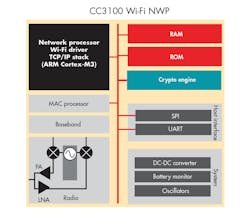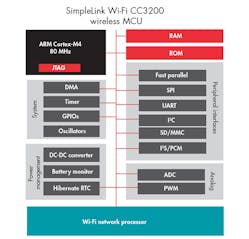’ SimpleLink family of integrated circuits is just what any engineer needs to implement the Internet of Things (IoT). These flexible wireless chips make it fast and easy to build products that connect nearly anything to anything else via the Internet using Wi-Fi. The CC3100 and CC3200 chips, plus their development systems, allow engineers with little or no wireless or Internet software experience to build a reliable IoT or machine-to-machine (M2M) product (Fig. 1).
Potential applications abound. Home and building automation are core targets. Examples include HVAC and lighting control. Smart energy is another good application destination. Adding monitoring and control devices to electrical meters and power panels can bring energy savings. Another possibility is multimedia for audio and video streaming and even advanced remote control. Security systems are an excellent application and that includes video monitoring of homes or industrial settings. There are also hundreds of industrial monitoring and control uses including factory automation and process control. Another untapped potential is real-time location systems (RTLS) that use Wi-Fi to track assets and to implement other location services.
While almost any wireless technology can be made to work in an IoT or M2M product, designers are discovering the simple fact that with Wi-Fi virtually everywhere, it is the go-to choice for the fastest low-cost Internet connectivity. Today Wi-Fi is available in most businesses and industrial locations as well as public sites. Furthermore, most homes also now incorporate a Wi-Fi router along with their high-speed Internet connection. This gives Wi-Fi the competitive edge in IoT and some M2M designs. Using some other wireless technology like Bluetooth or ZigBee requires the addition of a special gateway system for connection to the Internet. This added equipment and its attendant cost and design complexity makes this solution less desirable unless special considerations overrule the use of Wi-Fi.
This file type includes high resolution graphics and schematics when applicable.
On the other hand, Wi-Fi is not a cinch. It is a complex wireless technology that is difficult to understand and program. Some experience with Wi-Fi is typically needed to create a practical product or system. In addition, Wi-Fi is generally known as a high-power wireless technology. This is not a positive trait for an IoT product. Both of these problems are solved by the TI SimpleLink system.
The SimpleLink system consists of two basic chip configurations and the development system. The CC3100 incorporates a 2.4 GHz Wi-Fi radio compatible with 802.11b/g/n standards. The chip is also a complete self-contained network processor with on-chip Web server and TCP/IP stack (Fig. 2). The chip needs a 40 MHz external crystal, some serial flash, and an antenna filter. The CC3100 is designed to connect to any external microcontroller such as TI’s popular MSP430 series MCUs. Standard UART and SPI interfaces are provided for this connection. The device is housed in a 64-pin 9x9 mm QFN package.
The CC3200 contains the complete radio and Web server circuitry and TCP/IP stack of the CC3100, but eliminates the need for an external MCU. The CC3200 integrates a complete 80 MHz ARM Cortex M4 MCU, related RAM and ROM, and attendant interfaces (Fig. 3). The peripheral interfaces include fast parallel camera I/O, I2S audio, SDMMC, UART, I2C, SPI, and GPIOs. Analog capability includes internal ADC and PWM. A real-time clock (RTC) is provided.
There are several key features that make the SimpleLink system desirable for fast-to-market applications. First, the chips are fully Wi-Fi Alliance certified ensuring full interoperability. Second is the low power operation. These chips are designed to operate on two AA cells for over a year, thanks to low power connectivity modes that provide always-on or intermittent connections. The sleep current while connected to the network is only 120 µa. One mode features long sleep intervals up to 2 seconds with typical wake-up every 100ms. Receive listen current is only 37 ma for beacon reception. Another mode offers a 4 µa hibernate current that minimizes drain, but provides a 95 ms wake-up time for a 200 ms connection time.
Security is another core benefit of SimpleLink. On-chip Wi-Fi security includes WPA2 Personal, WPA2 Enterprise, and WPS2. Internet security includes on-chip SSL 3.0, TLS 1.2, and X.509. Finally, TI says that fully plug-and-play modules are on the way.
Rounding out the SimpleLink package is a set of development tools that facilitate design. The packages include development boards, reference designs, and a software development kit (SDK) that provides software drivers, sample applications, and API guides. Full user documentation and community support are also part of the package.
If you are getting ready to jump on the IoT or M2M bandwagon, SimpleLink may be your best option.





